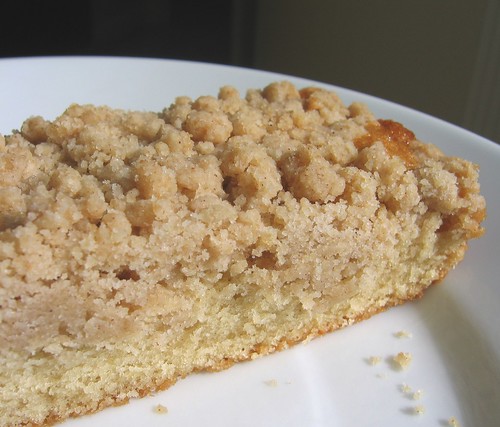
I’ve been a loyal Cook's Illustrated magazine reader for almost a decade now. There are no advertisements and the pictures are mostly illustrated (although there are some small photographs on the inside back cover). I love their scientific approach to cooking and the over-the-top attention to detail, but sometimes they can take it a bit too far.
For instance, they complained about using the typical creaming method when making an applesauce cake. According to the author, creaming the butter and sugar, adding eggs and then alternatively adding the dry ingredients and applesauce resulted in an elegant refined crumb but was "an awful lot of fuss for such a simple cake". So they preferred to mix the batter using the muffin method of mixing the wet ingredients by hand before adding the dry ingredients also by hand which produced "a more casual crumb that was better suited to a rustic snack cake". Okay, I don't really have a problem with choosing the most appropriate mixing method that gives the desired texture. But I did have a problem with their solution to increase the apple flavor of the cake. The author decided to simmer dried apple chunks in some apple cider until the liquid evaporates, allow the mixture to cool, put the now re-hydrated apples with the concentrated cider along with some applesauce into a food processor, whirl to make a smooth puree, and then add that puree to the cake batter. Apparently this was not too much fuss for this simple rustic apple cake. I understand that the point was to make the cake more apple-y but this solution was a bit mad.
So that is one of the reasons for my love-hate relationship with CI. Another is the restrictive nature of their recipes. As a baker and a scientist, I understand the need for precision. And because their recipes are designed with such scientific precision, the seemingly tiny details are actually not so tiny. A sauce recipe called for 2 tablespoons of tomato paste per 3 pounds of beef. According to CI, that tiny addition caused their tasters to exclaim "Wow, what did you do?" and made the beefy flavor more intense. However, using 3 tablespoons made my sauce taste of nothing but tomatoes. All my years of cooking told me that the extra amount of tomato paste shouldn’t have severely affected the outcome, but somehow it did. The normal rules just don’t apply when using a CI recipe. I’ve found that there is no wiggle room even with the non-pastry / non-baking recipes.
In any case, the article that accompanies each recipe is almost as, and in some case more, important than the recipe itself. The article gives the author a chance to explain the method to the madness. This is the issue I have with testing their recipes as a "Friend of Cook's". (For those who don't already know, anyone can sign up to be a "Friend" and try out CI recipes before they are published in their magazine. All they ask is that you try the recipe and provide some feedback before the deadline.) The mad methods that end up in many of their recipes need more explanation than what is provided with the test recipe. I guess I’ve gotten so used to knowing all the reasons behind the recipe that I don't want to just follow a CI recipe blindly. I am bursting with questions like a child who has to know why before doing anything. With the test recipes, I have no choice but to forge ahead blindly, putting my faith in the recipe.
I have no idea if this test recipe for New York style crumb cake was a successful "recreation of the crumb cakes of New York’s past" but it was a delicious and simple cake. And y’all know how I adore simple. I only had one question when testing this recipe. Why use cake flour instead of all-purpose flour in the crumb topping? I could make an educated guess but I would like some confirmation from CI. I guess I’ll have to wait until the magazine comes out in a few months.
EDITED (February 17, 2007): I removed the Cook's Illustrated recipe from my post per the CI magazine's request. I apologize for any inconvenience. -Mary
















 //PART 2
//PART 2
0 comments:
Post a Comment